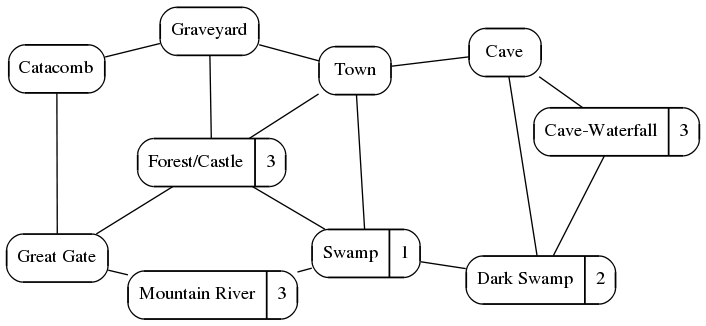I was looking over the nodes in this adventure, and I found a few things that want explanation. This is a great opportunity to practice ‘Challenge and Response‘ analysis (I’m leaving out ‘Secret’ for now).
Let’s break out the graph, the node map, for context.

Why is the town linked to the swamp rather than the river? Most settlements want a source of fresh water, rivers are good for that. This is a response-before-challenge sort of thing: I know what they did, but not why. They chose to build the town away from the river, so there must be a reason. The swamp immediately downriver provides a good hint: the river hits a relative flat spot, a floodplain. Every year during the wet season, the entire place is underwater, and the land there is not nearly solid enough that you’d want to build a town on it. The town is in the hills just the other side of the forest, closer to the swamp than to the river.
The town is surrounded by a forest, a swamp, a graveyard, and there are caves nearby. Where does the town get its food? Presumably there is some farming in the hills and some gathering in the forest, but that won’t support a town. Supplies could also be brought in by road (I didn’t mention one, but surely there is a road into and out of this area, and the town would be a likely stop on the way to the castle). However, flood plains are often pretty fertile because of the fresh soil full of nutrients brought from upriver. The plains are not really suitable to build a town on, but I think the floodplain will be well-farmed during the appropriate season.
Surely the farmers don’t sleep in the (running) mud during the wet season! Where do they live? They could migrate, use mobile or temporary shelters during the farming season and living elsewhere during the wet season. I think the settlements will be more or less permanently built, but only occupied when needed.
So every spring they have to shovel out the mud and dead animals and other detritus that washed in from upriver? No, the houses, such as they are, are built on firm solid pilings and are several feet above the ground, usually enough to keep the water out. Upriver of each settlement is a curved wall of pilings that lets much of the water through but catches, ‘strains out’ if you will, the larger debris and slows the water down. The villages still get flooded, but the worst of the mess is below floor level and doesn’t include nearly so many trees or dead animals.
This is far from a complete treatment. In fact, I’ve really only looked at one primary question (why isn’t the town on the river?) and spun off into some questions raised by the original answer. This is pretty common and might be worth keeping an eye on. A challenge and response exercise can become a rabbit hole of question and answer, and it’s easy to get caught up in minutiae, but the results can be rewarding.
